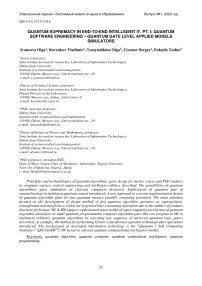Quantum supremacy in end-to-end intelligent IT. Pt. I: quantum software engineering - quantum gate level applied models simulators
Автор: Ivancova Olga, Korenkov Vladimir, Tyatyushkina Olga, Ulyanov Sergey, Fukuda Toshio
Журнал: Сетевое научное издание «Системный анализ в науке и образовании» @journal-sanse
Статья в выпуске: 1, 2020 года.
Бесплатный доступ
Principles and methodologies of quantum algorithmic gates design for master course and PhD students in computer science, control engineering and intelligent robotics described. The possibilities of quantum algorithmic gates simulation on classical computers discussed. Applications of quantum gate of nanotechnology in intelligent quantum control introduced. A new approach to a circuit implementation design of quantum algorithm gates for fast quantum massive parallel computing presented. The main attention focused on the development of design method of fast quantum algorithm operators as superposition, entanglement and interference, which are in general time-consuming operations due to the number of products that have performed. SW & HW support sophisticated smart toolkit of supercomputing accelerator of quantum algorithm simulation on small quantum programmable computer algorithm gate (that can program in SW to implement arbitrary quantum algorithms by executing any sequence of universal quantum logic gates) described. As example, the method for performing Grover’s interference operator without product operations introduced. The background of developed information technology is the "Quantum / Soft Computing Optimizer" (QSCOptKBTM) SW based on soft and quantum computational intelligence toolkit.
Quantum algorithm, quantum computer, quantum computation intelligence, quantum programming
Короткий адрес: https://sciup.org/14123309
IDR: 14123309
Список литературы Quantum supremacy in end-to-end intelligent IT. Pt. I: quantum software engineering - quantum gate level applied models simulators
- Horowitz M., Labonte F., Olukotun K. and C. Batten. New plot and data collected for 2010-2015 [by K. Rupp].
- Pino J. M., Demonstration of the QCCD trapped-ion quantum computer architecture // arXiv:2003.01293v1 [quant-ph] 3 Mar 2020. Taken by Erik Lucero (b) IBM five-qubit universal quantum computer http://web.physics.ucsb.edu/~martinisgroup/photos.shtml, (released May 2016).
- Salm M. A Roadmap for Automating the Selection of Quantum Computers for Quantum Algorithms // arXiv:2003.13409v1 [quant-ph] 30 Mar 2020.
- Wilhelm F.K. et al. Entwicklungsstand Quantencomputer. — Federal Office for Information Security. — 2017.
- Benedetti M. Parameterized quantum circuits as machine learning models // Quantum Sci. Technol. — 2019. — Vol. 4. — Pp. 043001.
- Leymann F., Barzen J., Falkenthal M. Quantum in the Cloud: Application Potentials and Research Opportunities // arXiv: 2003.06256[quant-ph]. 2020.
- Josephson Junction Quantum Computing at UCSB http://web.physics.ucsb.edu/~martinisgroup/photos.shtml, taken by Erik Lucero (b) IBM five-qubit universal quantum computer (released May 2016).
- Debnath S., Linke N. M., Figgatt C., Landsman K. A., Wright K. and C. Monroe. Demonstration of a programmable quantum computer module. // arXiv: 1603.04512 v1 [quant-ph], 2016.
- Quantum Image Processing: the truth, the whole truth, and nothing but the truth about its problems on internal image representation and outcomes recovering // arXiv: 2002.04394 v1 [quant-ph], 2020.
- Benedetti M. Parameterized quantum circuits as machine learning models // Quantum Sci. Technol. — 2019. — Vol. 4. — Pp. 043001.
- ZOU X. Enhancing a Near-Term Quantum Accelerator’s Instruction Set Architecture for Materials Science Applications // IEEE Trans. On Quantum Engineering. — 2020. — Vol. 1. — Pp. 4500307 [DOI 10.1109/TQE.2020.2965810].


